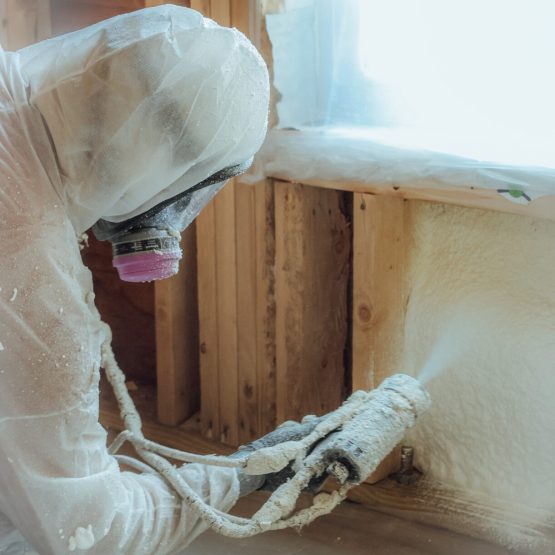Spray Foam Insulation Installation in New England
A Safe Way to Insulate Your Home or Business
Any homeowner in New England can tell you what their biggest financial pain point is: their monthly energy bills! As energy costs continue to rise, homeowners are looking for effective and innovative ways to alleviate their wallets. However, there’s a hidden cause of these rising prices that you may not be aware of. Is your home properly insulated? If not, Advanced Green Insulation can provide spray foam insulation installation services for all of New England!

How Does Spray Foam Insulation Work?
Spray foam insulation is one of the most effective types of insulation to install for a big reason! When spray foam comes into contact with oxygen, it expands to fill in the space around it. This makes it incredibly effective at filling in the small cracks and crevices that other types of insulation don’t reach as easily. Spray foam insulation expands to many times its original size, creating an airtight seal that prevents heat loss and combats air infiltration. If you’re looking for a way to increase your home’s energy efficiency, spray foam insulation has you covered!
The Two Types of Spray Foam Insulation
There are two main types of spray foam insulation – both of which we can install for you in New England! They are open-cell foam insulation and closed-cell foam insulation. Each has different benefits to offer, so it’s important to know the difference to help your home perform at its best! We’ll explain the details for you below!
Open-Cell Spray Foam Insulation Installation in Rockland, MA
Open-cell spray foam insulation: what it is, what it’s for, and its benefits
Open-Cell Spray Foam Insulation, also known as open-cell spray foam insulation, is one of the most effective and versatile solutions for thermal and acoustic insulation in residential and commercial buildings. This technology uses an expanding polyurethane-based foam that, when applied, expands rapidly to fill all cracks and spaces, creating a continuous and efficient barrier.
What is open-cell spray foam insulation?
Open-cell spray foam is lightweight, flexible foam whose cells, or bubbles, are partially open, which differentiates it from closed-cell spray foam insulation. This open-cell structure allows air to circulate through the foam, providing some unique characteristics, such as superior sound insulation and a certain “breathing” capacity, allowing moisture to pass through in small volumes.
What is Open-Cell Spray Foam Used For?
Open-cell foam insulation is widely used for a variety of purposes, including:
1) Thermal insulation: reduces heat transfer, making indoor environments more comfortable and improving the property’s energy efficiency.
2) Acoustic insulation: Due to its lightweight and porous nature, open-cell foam is excellent at absorbing sounds, making it an effective solution for those seeking noise reduction.
3) Sealing cracks and gaps: The foam’s expansive capacity allows it to fill small cracks and spaces, ensuring an efficient seal against air infiltration.
4) Moisture control: Although not completely waterproof like closed-cell foam, open-cell foam allows a limited passage of water vapor, helping to control humidity in some applications.
Benefits of Open-cell Spray Foam Insulation
- Efficient thermal insulation: Open-cell foam helps maintain stable indoor temperatures, reducing the need for heating and cooling systems and, consequently, reducing energy consumption.
- Great value for money: Compared to closed-cell foam, open-cell foam is generally more affordable and covers larger surfaces with less material, making it ideal for residential construction.
- Superior acoustic insulation: Because it is more flexible and has a porous structure, open-cell foam is highly effective in reducing noise transmission, making it a popular choice for those seeking privacy and acoustic comfort.
- Filling capacity: Due to its expansion, open-cell spray foam easily fills small spaces and cracks, providing an almost complete seal that prevents air infiltration, which improves the energy efficiency of the property.
- Flexibility and lightness: Its lighter and more malleable composition makes it ideal for situations where flexibility is necessary, such as areas with high structural movement or difficult to access.
- Environmentally friendly: Many versions of open-cell foam are made from more sustainable materials, offering an eco-friendly insulation solution.
Closed-Cell Spray Foam Insulation in Rockland, MA
Closed-Cell Spray Foam Insulation: What It Is, What It’s For, and Its Benefits
Closed-Cell Spray Foam Insulation, or closed-cell spray foam insulation, is a cutting-edge technology used in construction to provide high-performance thermal and structural insulation. This expandable foam, composed of polyurethane, stands out for its closed-cell structure, which makes it denser and more rigid than its open-cell counterpart. Its application in walls, roofs, foundations, and other strategic areas of the building ensures effective protection against the weather and improves the building’s energy efficiency.
What is Closed-Cell Spray Foam Insulation?
Closed-Cell Spray Foam is made up of small cells that are completely closed, which prevents the passage of air and moisture. This characteristic makes the foam extremely dense and rigid, creating an impenetrable barrier to both air and water. This rigidity also adds structural value to the construction, reinforcing the surfaces where it is applied. When sprayed, the foam expands, completely filling the spaces and creating a continuous and highly resistant seal, ideal for ensuring superior insulation in critical areas of a building.
What is Closed-Cell Spray Foam Used For?
Closed-cell spray foam insulation offers a variety of applications, including:
1) High-performance thermal insulation significantly reduces heat transfer, providing greater energy efficiency in extreme climates, both hot and cold.
2) Moisture barrier: Closed-cell foam is impermeable, making it effective for areas subject to water infiltration, such as foundations, ceilings, and exterior walls.
3) Structural reinforcement: Due to its rigidity and density, closed-cell foam adds structural strength to the surfaces where it is applied, increasing the resistance of the building.
4) Air infiltration seal: The compact structure of the foam prevents air from entering, which helps reduce energy consumption by minimizing heat or cold escapes.
5) Insulation in critical areas: ideal for areas subject to high levels of humidity, such as basements, roofs, and environments with large temperature variations.
Benefits of Closed-Cell Spray Foam Insulation
- Maximized energy efficiency: Closed-cell foam offers one of the best insulation coefficients (R-value) available on the market, making it ideal for projects that require high thermal performance.
- Waterproofing: One of the greatest advantages of closed-cell foam is its ability to act as a barrier against water and moisture. This makes it an excellent choice for areas such as basements, roofs, and exterior walls that need protection against infiltration.
- Adding structural strength: When Closed-Cell Spray Foam expands and hardens, it also acts as a structural reinforcement, increasing durability and resistance to impacts and weathering in wood and metal buildings.
- Sealing against air and pollutants: Due to its dense nature, closed-cell foam creates a complete barrier against air infiltration, helping to keep the interior environment free of unwanted drafts, in addition to blocking the entry of dust, pollutants, and allergens.
- Mold and moisture reduction: Because it is waterproof and completely seals surfaces, closed-cell spray foam prevents moisture penetration, which is the main cause of mold growth in building structures.
- Long-term durability: Closed-cell spray foam is one of the most durable insulation materials on the market, maintaining its performance for decades without needing frequent replacements.




